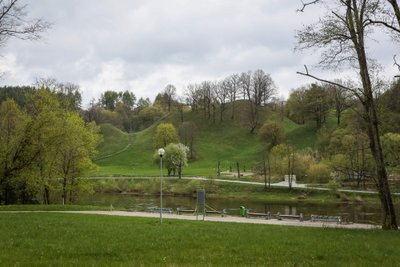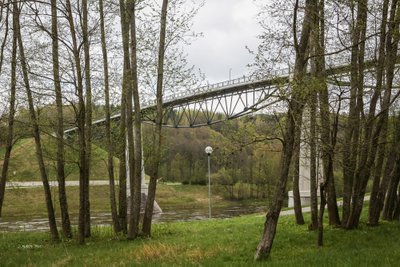Fundamental sustainable development principles are being followed
“The Green City” – that’s how locals and guests call Alytus, according to the Alytus City Municipality Administration Environmental Protection Department’s head Vida Macerniene.
“And really, it is one of the unique Lithuanian cities where over 30% of the territory is covered by parks, gardens, forests, and pinewoods. The city appreciates, cherishes, and boasts about this fact,” she said.
According to her, the environmental changes in Alytus, just like in the entire Lithuania, are taking place hand in hand with the economic ones.
“When the economic situation gets worse, the environmental situation gets better, and as soon as the economy starts recovering, the environment unavoidably takes a hit. With economy rising, urban expansion usually gets more intense, the transport infrastructure grows, more areas are used for building, the use of natural resources increases – as well as pollution.
The majority of economic factors affect the environment. Thus, in order to ensure proper environmental protection and achieve set goals, it is imperative that the economy grows following the principles of sustainable development, i.e. by harmonizing environmental, economic, and social goals and limiting environmental damage,” she noted.

Main principles in greater detail
“According to the national sustainable development strategy, the allowable EU norms should not be exceeded. Reaching such a goal is only possible by implementing the latest technologies that are less damaging to the environment, for example, cleaner manufacturing processes and low-waste facilities, especially in the areas of natural-resource use, waste management and recycling, and soil-cleaning products.
A close cooperation between the transport, construction, and other sectors is necessary when dealing with climate change, air pollution reduction, the preservation and improvement of natural resources and environmental quality, waste reduction, and the preservation of biological and landscape diversity issues,” Macerniene added.
The Alytus City Municipality is taking all this into account and invites the citizens to take part in decision-making processes.
“We are constantly striving to involve the residents in the decision-making process. It is necessary to increase their awareness and competence in the area of environmental protection, inform them about their impact on the environment, and the possibilities to choose more sustainable types of activities,” head of the Alytus City Municipality Administration Environmental Protection Department stressed.

Alytus – a city within a park
Alytus is called one of the greenest cities in Lithuania or a city within a park because parks and forests encircle it.
“This city stands in an area with great recreational potential. Natural diversity makes the city attractive to the locals and guests. The area of Alytus, including bodies of water and forests, is 3943 hectares. The total area of green spaces is about 214.7 hectares, or 5.4% of the city’s area. Statistically speaking, there are 41 square meters of green spaces per one resident of Alytus,” Macerniene continued.
Alytus truly has many parks.
“The city has the following parks: City Garden Park, Resort Park, Youth Park, Likiskes Park, Gulbynes Park, Putinai Park, Student Square, Seagull Hill Park, Alytus Grove, Nemunas Valley Park, Alytupis Park, and others. The parks have a huge recreational potential and are frequently visited,” she said.
Green areas have been around in Alytus for several decades. The city’s geographical location makes it easier to develop parks.
“As early as 1926, the forming of the Alytus City Garden Park began. Today, the park’s area is about six hectares. In 1999, the Alytus City Garden Park was included in the Republic of Lithuania List of Intangible Cultural Heritage. Currently, a technical project is being prepared to renovate the park’s pathways, reconstruct engineering networks, lighting, fountain, build a parking lot, add some elements of small architecture, and order the green spaces,” Macerniene explained.

According to her, there is a 92-hectare forest park adjacent to the City Garden Park.
“It includes the city stadium, the so-called Resort, the small Lake Dailide, and the Valley of Songs on the bank of the Nemunas. Beyond a 33-metre-high embankment, the forest continues, and there’s also the wash – the large Lake Dailide. Both lakes are 1 kilometer away from the city center, in the Resort Park,” Macerniene told DELFI.
Bu there are more green spaces in Alytus.
“Within the city’s territory, there is the 452-hectare Vidzgiris Forest. In 1960, it was declared a botanical reserve. The forest is home to rare plants of extreme botanical value and numerous protected animal species. The Radziunai Mound is among the reserves attractions. In order to help people get acquainted with these natural wonders, an ecological educational trail has been built, complete with information arrows to point visitors in the right direction, information stands, places of rest, and benches. In winter, this trail is suitable for skiing,” she said.
Waste sorting
Alytus was one of first Lithuanian cities to start experimenting with waste sorting.
“In Alytus, the sorting of kitchen/food waste was introduced in October 2018. Such waste is collected not just from individual houses and blocks of flats, but also from budget, education, healthcare, and other municipality institutions that provide catering services. The experiment has been a success. The residents are recommended to use kitchen/food waste as compost,” Macerniene stressed.

Future plans
According to her, in order for the city to be able to use the environmental advantages in the future, the Alytus City Municipality gives equal focus to environmental and consumer goals.
“When addressing Alytus development plans, the Municipality Council pays special attention to the preservation of an ecologically stable environment and a full-fledged cultural landscape. The goals and objectives of the National Environmental Protection Strategy and the plans prepared by the Municipality (The Alytus Strategic Development Plan till 2030 and the general plan),” she said.
Macerniene told DELFI about another solution that makes the city unique.
“Alytus has become the first city in Lithuania where waste will be burned to heat homes and generate electricity for the city’s electric buses. We have purchased more electric buses, and they will be charged at the heat energy supplier’s territory. Now, Alytus has seven electric buses, another 25 are diesel-powered. In the coming years, they will be replaced by non-polluting ones,” the Alytus City Municipality Administration Environmental Protection Department’s head shared.

Residents enjoy sustainable living in Alytus
We asked Agne (name changed, actual name known to DELFI) what do the residents of Alytus think of the Municipality’s solutions and sustainable initiatives. Even though currently she lives in Vilnius, Agne often visits her hometown. As she puts it, the fact that Alytus has been recognized as one of the greenest cities in Lithuania makes her happy and proud.
“While living in the capital, I sometimes miss the sustainable solutions of Alytus. One of the most prominent ones being the electric buses (I’ve used them countless times). The trips are comfortable, the buses are new, well-adapted, they operate more silently, and, obviously, are more environmentally-friendly,” Agne said.
Nevertheless, she pointed out several things that still lacked the needed solutions.
“Last year, I saw a horribly polluted body of water. The little lake’s shores were covered with green/bluish sludge, and the smell was foul. It was difficult to believe that such is the condition of one of the city’s main attractions,” she continued.
Agne also admitted that she, too, contributed to making life in Alytus cleaner and more sustainable.
“I try to use public transport, which is now electric, or go on foot while enjoying a very green city that is full of parks, forests, and numerous pedestrian footpaths and bike paths – they also encourage travelling more sustainably,” she claimed.

